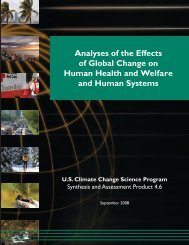Weather and Climate Extremes in a Changing Climate. Regions of ...
Weather and Climate Extremes in a Changing Climate. Regions of ...
Weather and Climate Extremes in a Changing Climate. Regions of ...
Create successful ePaper yourself
Turn your PDF publications into a flip-book with our unique Google optimized e-Paper software.
The U.S. <strong>Climate</strong> Change Science Program Appendix A<br />
132<br />
Figure A.7 Trend analysis for the square roots <strong>of</strong> 90-day heavy precipitation frequencies.<br />
For 1878-2005, us<strong>in</strong>g the one-encounter dataset, we f<strong>in</strong>d<br />
by ord<strong>in</strong>ary least squares a l<strong>in</strong>ear trend <strong>of</strong> .017 (storms per<br />
year), st<strong>and</strong>ard error .009, which is not statistically significant.<br />
Select<strong>in</strong>g a time series model by AIC, we identify an<br />
ARMA(9,2) model as best (an unusually large order <strong>of</strong> a<br />
time series model <strong>in</strong> this k<strong>in</strong>d <strong>of</strong> analysis), which leads to a<br />
l<strong>in</strong>ear trend estimate <strong>of</strong> .022, st<strong>and</strong>ard error .022, which is<br />
clearly not significant.<br />
When the same analysis is repeated from 1900-2005, we<br />
f<strong>in</strong>d by l<strong>in</strong>ear regression a slope <strong>of</strong> .047, st<strong>and</strong>ard error .012,<br />
which is significant. Time series analysis now identifies the<br />
ARMA(5,3) model as optimal, with a slope <strong>of</strong> .048, st<strong>and</strong>ard<br />
error .015–very clearly significant. Thus, the evidence is<br />
that there is a statistically significant trend over 1900-2005,<br />
though not over 1878-2005.<br />
A comment here is that if the density <strong>of</strong> the data is plotted<br />
as <strong>in</strong> several earlier examples, this suggests a square root<br />
transformation to remove skewness. Of course the numerical<br />
values <strong>of</strong> the slopes are quite different if a l<strong>in</strong>ear regression<br />
is fitted to square root cyclones counts <strong>in</strong>stead <strong>of</strong> the raw<br />
values, but qualitatively, the results are quite similar to<br />
those just cited–significant for 1900-2005, not significant<br />
for 1878-2005–after fitt<strong>in</strong>g a time series model. We omit<br />
the details <strong>of</strong> this.<br />
The second part <strong>of</strong> the analysis uses the “two-encounter”<br />
data set. In this case, fitt<strong>in</strong>g an ord<strong>in</strong>ary least-squares l<strong>in</strong>ear<br />
trend to the data 1878-2005 yields an estimated slope .014<br />
storms per year, st<strong>and</strong>ard error .009, not significant. The<br />
time series model (aga<strong>in</strong> ARMA(9,2)) leads to estimated<br />
slope .018, st<strong>and</strong>ard error .021, not significant.<br />
When repeated for 1900-2005,<br />
ord<strong>in</strong>ary least-squares regression<br />
leads to a slope <strong>of</strong> .042, st<strong>and</strong>ard<br />
error .012. The same analysis<br />
based on a time series model<br />
(ARMA(9,2)) leads to a slope <strong>of</strong><br />
.045 <strong>and</strong> a st<strong>and</strong>ard error <strong>of</strong> .021.<br />
Although the st<strong>and</strong>ard error is<br />
much bigger under the time series<br />
model, this is still significant with<br />
a p-value <strong>of</strong> about .03.<br />
EXAMPLE 6: U.S.<br />
lANDfAllINg<br />
hURRICANES<br />
(SECTION 2.1.3.1)<br />
The f<strong>in</strong>al example is a time series<br />
<strong>of</strong> U.S. l<strong>and</strong>fall<strong>in</strong>g hurricanes for<br />
1851-2006 taken from the website<br />
http://www.aoml.noaa.gov/hrd/<br />
hurdat/ushurrlist18512005-gt.txt. The data consist <strong>of</strong> annual<br />
counts <strong>and</strong> are all between 0 <strong>and</strong> 7. In such cases a square<br />
root transformation is <strong>of</strong>ten performed because this is a variance<br />
stabiliz<strong>in</strong>g transformation for the Poisson distribution.<br />
Therefore, square roots have been taken here.<br />
A l<strong>in</strong>ear trend was fitted to the full series <strong>and</strong> also for the<br />
follow<strong>in</strong>g subseries: 1861-2006, 1871-2006, <strong>and</strong> so on up<br />
to 1921-2006. As <strong>in</strong> preced<strong>in</strong>g examples, the model fitted<br />
was ARMA (p,q) with l<strong>in</strong>ear trend, with p <strong>and</strong> q identified<br />
by AIC.<br />
For 1871-2006, the optimal model was AR(4), for which<br />
the slope was -.00229, st<strong>and</strong>ard error .00089, significant<br />
at p=.01.<br />
For 1881-2006, the optimal model was AR(4), for which<br />
the slope was -.00212, st<strong>and</strong>ard error .00100, significant<br />
at p=.03.<br />
For all other cases, the estimated trend was negative, but not<br />
statistically significant.




